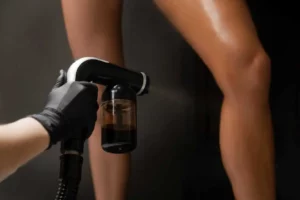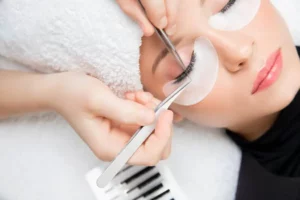For many people, having a sun-kissed glow is desirable to boost their confidence and enhance their appearance. However, with the well-known risks associated with sun exposure, it’s no surprise that more and more people are turning to spray tans as a safer alternative. But do spray tans work?
Despite their growing popularity, there’s still some debate around the effectiveness of spray tans. In this article, we’ll explore how spray tans work, their pros and cons, and offer tips for getting the best results. By the end, you’ll better understand whether spray tans can help you achieve your desired natural tan.
What Are Spray Tans?
Spray tans are a cosmetic treatment that provides the appearance of a natural, sun-kissed tan without the need for UV exposure. Using a spray gun or other spray application methods, they use a chemical solution on the skin.
Different types of spray tans are available, such as airbrush tans, booth tans, and handheld spray tans, and each has its unique application method. Airbrush tans involve a technician spraying the solution onto the skin using an airbrush gun, while booth tans involve stepping into a booth that sprays the solution from different angles. Handheld spray tans affect a portable spray gun that can apply the answer to the skin.
How Do Spray Tans Work?
Have you ever wondered how a simple chemical reaction can turn your skin from pale to golden in hours? Well, that’s precisely what happens when you get a spray tan. The magic ingredient in spray tans is dihydroxyacetone (DHA). This colorless sugar reacts with the proteins and amino acids in the top layer of your skin to create a brown pigment known as melanoidin.
This process is known as the Maillard reaction, which occurs when you cook food at high temperatures. In the case of spray tans, DHA reacts with the amino acids and proteins in the outermost layer of your skin to create melanoidin, a brown pigment that gives your skin a natural-looking tan.
The depth of the tan depends on the concentration of DHA in the spray tan solution and the amount of time the answer is left on the skin. Typically, spray tans take several hours to develop fully, with the final color becoming apparent within 24 hours. Depending on the solution’s concentration and the individual’s skin type, the color may continue to develop for up to 48 hours after application.
The Effectiveness of Spray Tans
When it comes to the effectiveness of spray tans, there are a few key factors to consider.
Quality of Spray Tan Solution
The quality of the spray tan solution is crucial in determining how well the tan develops and how long it lasts. The concentration of dihydroxyacetone (DHA), the active ingredient in most spray tan solutions, can vary between brands and formulations. A higher concentration of DHA typically results in a darker and longer-lasting tan. In addition to DHA, the quality of the other ingredients, such as moisturizers or antioxidants, can also impact the effectiveness of the spray tan.
Application Method and Technique
The application method and technique used by the technician can significantly impact the final result of the spray tan. Factors such as the spray nozzle’s angle, the distance between the nozzle and the skin, and the amount of solution used can all affect the tan’s appearance and longevity. The technician’s skill and experience are also critical in ensuring a smooth and even application.
Individual’s Skin Type and Condition
The individual’s skin type and condition can impact the longevity and appearance of the spray tan. Dry skin, for example, can cause the tan to fade more quickly. Skin conditions such as eczema or psoriasis can also affect the spray tan’s appearance and longevity. In addition, individuals with naturally oily skin may find that the spray tan fades more quickly or appears uneven.
Skin Preparation
Preparing the skin before the spray tan can also impact the tan’s effectiveness. Exfoliating the skin before the spray tan is recommended to remove any dead skin cells that may interfere with the solution’s absorption. Shaving or waxing should also be done before the spray tan to prevent patchiness or uneven fading.
Post-Tan Care
After the spray tan, taking care of the skin is essential to extend the tan’s longevity and prevent uneven fading. Moisturizing the skin regularly can help to keep it hydrated and prevent the tan from fading prematurely. Avoiding activities that cause sweating, such as intense exercise, can also help maintain the tan’s appearance. Finally, avoiding prolonged exposure to water, such as swimming or bathing, can also help to extend the tan’s longevity.
Are Spray Tans Safe?
Spray tans have become an increasingly popular alternative to traditional tanning methods. However, many people may wonder whether spray tans are safe and what potential risks or side effects may be associated with this cosmetic treatment. While spray tans are generally considered safe, there are several factors to consider regarding the safety and effectiveness of this treatment.
- Chemical Composition of Spray Tan Solutions: While the active ingredient in most spray tan solutions, dihydroxyacetone (DHA), is generally considered safe, some individuals may experience adverse reactions. For example, some people may be allergic to DHA, which can cause itching, redness, and swelling. In addition, other ingredients in the spray tan solution, such as fragrances or preservatives, may cause skin irritation or allergic reactions.
- Inhalation of Spray Tan Solution: When spray tans are applied, some of the solutions can become airborne and may be inhaled. While the amount of spray tan solution inhaled is generally considered safe, some people may experience respiratory symptoms, such as coughing or wheezing, after exposure to the solution. It is recommended to wear a mask or other protective gear during the spray tan application process to reduce the risk of inhalation.
- Eye and Mucous Membrane Exposure: Spray tans can also risk the eyes and mucous membranes. If the solution comes into contact with the eyes, it can cause irritation or redness.
- Sun Sensitivity: DHA can cause increased sensitivity to sunlight, so individuals who have recently had a spray tan should avoid prolonged sun exposure or tanning beds. Wear sunscreen as much as you can.
Do Spray Tans Work?
If you’ve been skeptical about the effectiveness of spray tans, it’s time to try them and see the results for yourself! While spray tanning may seem simple, the science behind it is fascinating.
With the right spray tan solution and application technique, you can achieve a beautiful and natural-looking tan lasting for days. So if you’re looking for a safe and effective way to get that summer glow all year round, why not try a spray tan today? You may be surprised at how well they do work! Contact Thrive Aesthetics and Wellness to learn more about our services today!









